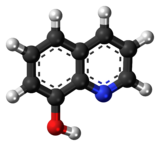Oxyquinoline
 |
|
 |
|
| Names | |
|---|---|
|
IUPAC name
Quinolin-8-ol, 8-Quinolinol
|
|
| Other names
1-azanaphthalene-8-ol, Fennosan H 30, hydroxybenzopyridine, hoxybenzopyridine, oxychinolin, oxyquinoline, phenopyridine, quinophenol, oxine
|
|
| Identifiers | |
|
148-24-3 |
|
| 3D model (Jmol) |
Interactive image Interactive image |
| ChEBI |
CHEBI:48981 |
| ChEMBL |
ChEMBL310555 |
| ChemSpider |
1847 |
| ECHA InfoCard | 100.005.193 |
| KEGG |
D05321 |
| PubChem | 1923 |
| UNII |
5UTX5635HP |
|
|
|
|
| Properties | |
| C9H7NO | |
| Molar mass | 145.16 g/mol |
| Appearance | White crystalline needles |
| Density | 1.034 g/cm3 |
| Melting point | 76 °C (169 °F; 349 K) |
| Boiling point | 276 °C (529 °F; 549 K) |
| Pharmacology | |
| G01AC30 (WHO) A01AB07 (WHO) D08AH03 (WHO) R02AA14 (WHO) | |
| Hazards | |
| Main hazards | flammable |
| Safety data sheet | External MSDS |
|
Except where otherwise noted, data are given for materials in their standard state (at 25 °C [77 °F], 100 kPa).
|
|
|
|
|
| Infobox references | |
8-Hydroxyquinoline is an organic compound with the formula C9H7NO. It is a derivative of the heterocycle quinoline by placement of an OH group on carbon number 8. This light yellow compound is widely used commercially, although under a variety of names.
It is usually prepared from quinoline-8-sulfonic acid and from Skraup synthesis from 2-aminophenol.
8-Hydroxyquinoline is a monoprotic bidentate chelating agent. In neutral solution, the hydroxyl is in the protonated form (pKa=9.89) and the nitrogen is not protonated (pKa=5.13). However, an excited-state zwitterionic isomer exists in which H+ is transferred from the oxygen (giving an oxygen anion) to the nitrogen (giving a protonated nitrogen cation).
The complexes as well as the heterocycle itself exhibit antiseptic, disinfectant, and pesticide properties, functioning as a transcription inhibitor. Its solution in alcohol is used in liquid bandages. It once was of interest as an anti-cancer drug.
The reaction of 8-hydroxyquinoline with aluminium(III) results in Alq3, a common component of organic light-emitting diodes (OLEDs). Variations in the substituents on the quinoline rings affect its luminescence properties.
The roots of the invasive plant Centaurea diffusa release 8-hydroxyquinoline, which has a negative effect on plants that have not co-evolved with it.
...
Wikipedia
